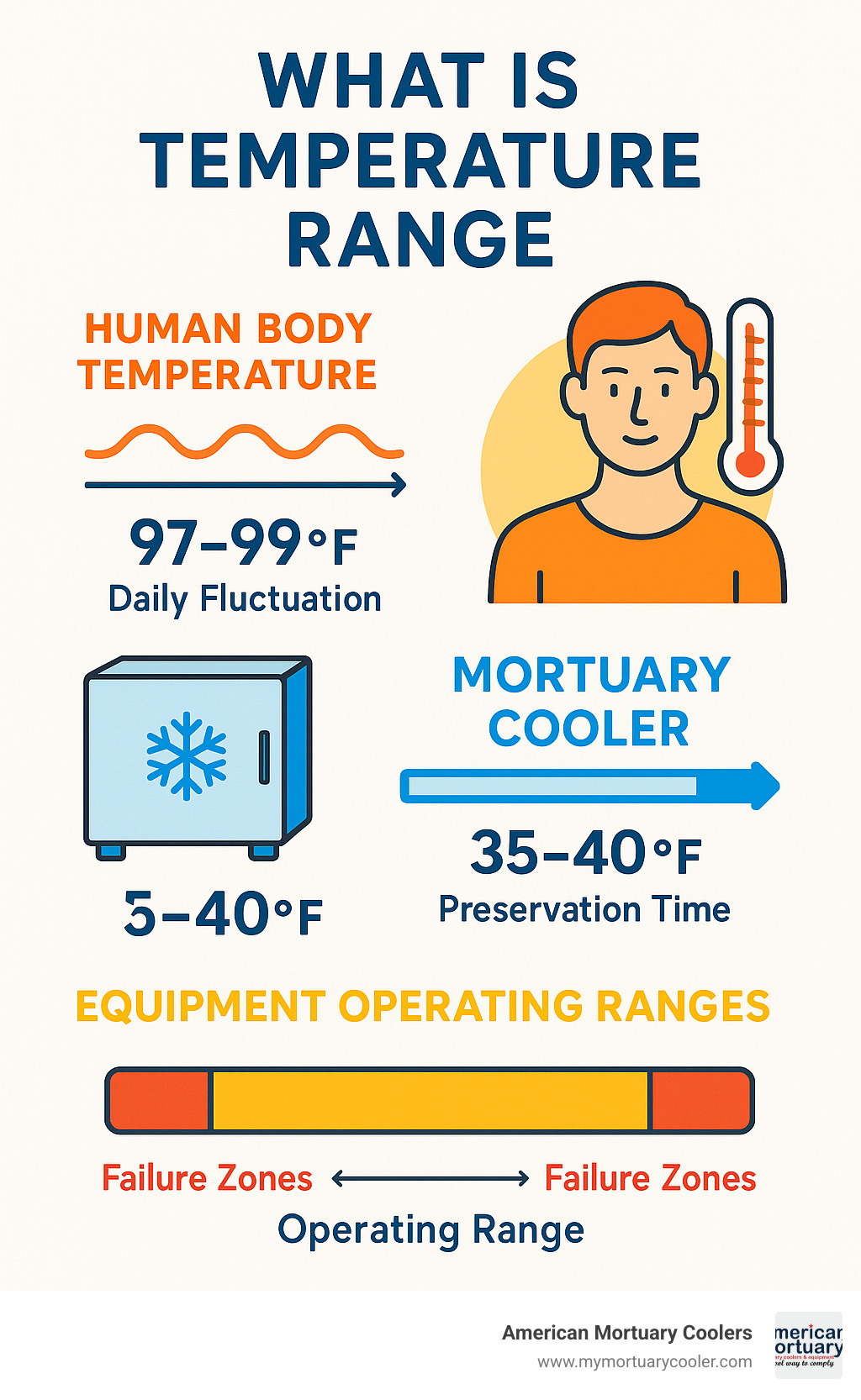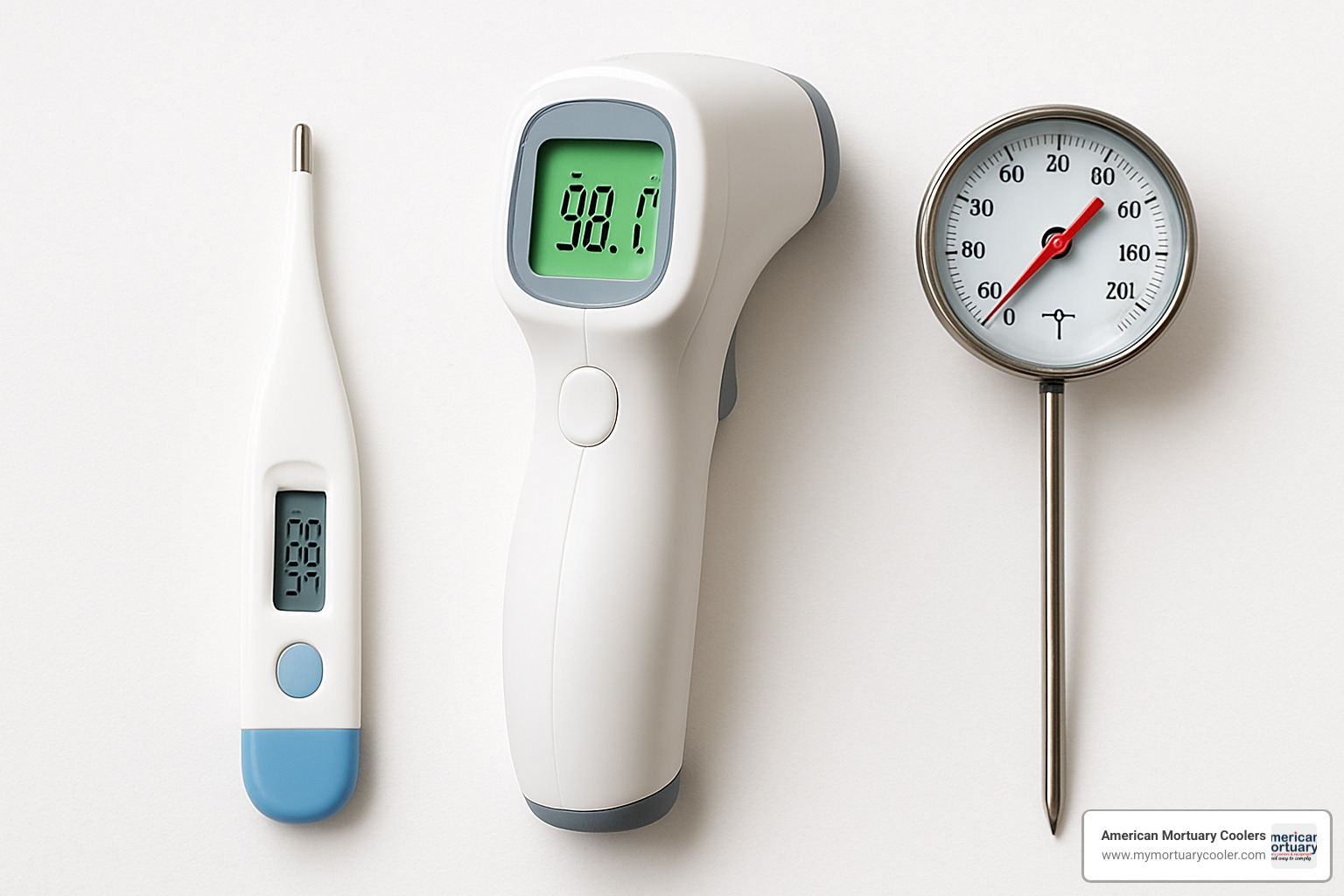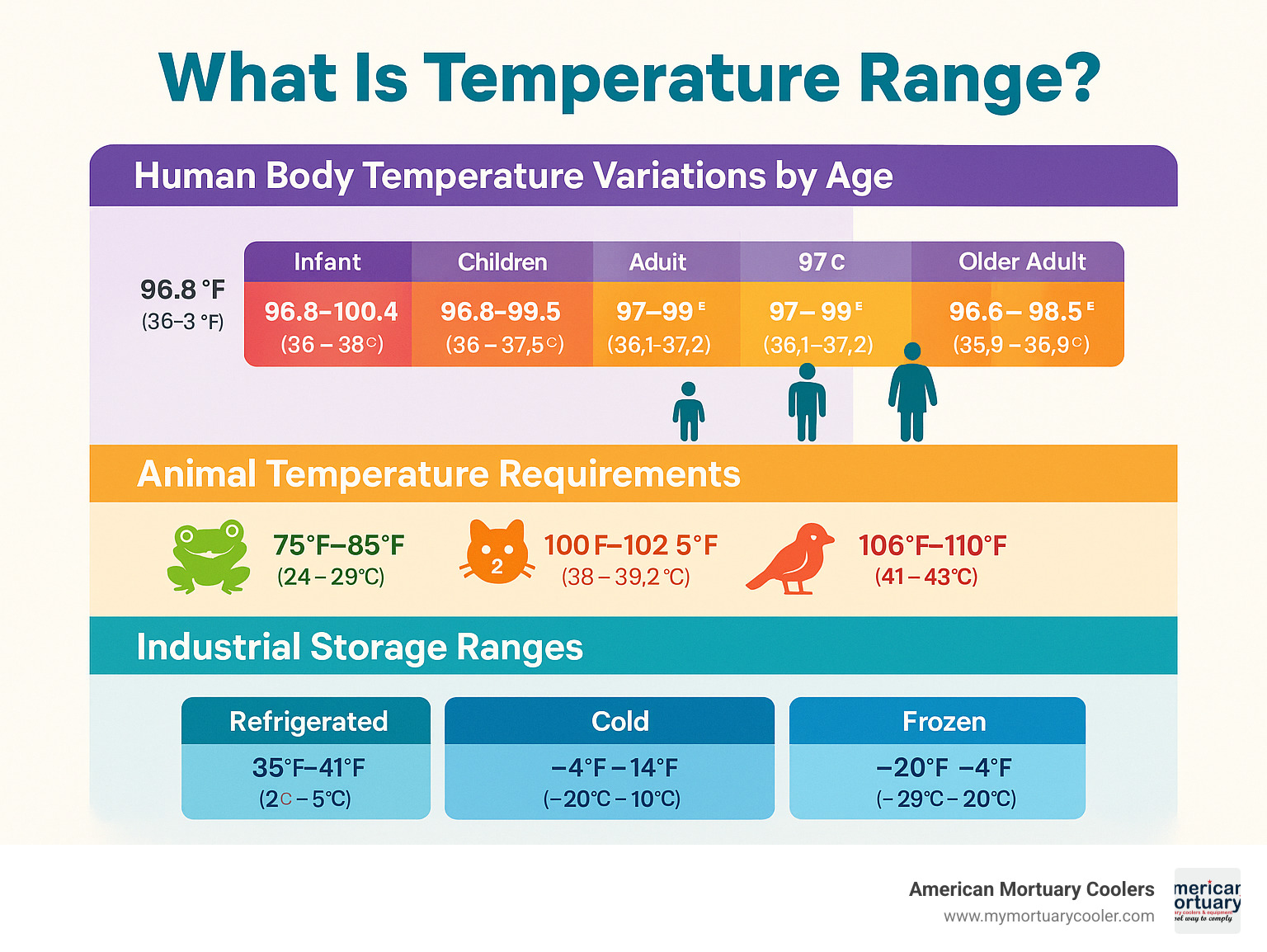Why Understanding Temperature Range Is Critical for Professional Operations
What is temperature range - it's the difference between the highest and lowest temperatures recorded over a specific period or within a defined system. Whether you're monitoring human health, maintaining equipment, or preserving biological materials, temperature range serves as a fundamental measurement that guides critical decisions.
Quick Answer: Temperature Range Basics
- Definition: The span between maximum and minimum temperatures
- Human body: Normal range is 97°F to 99°F (36.1°C to 37.2°C)
- Measurement: Calculated as highest temperature minus lowest temperature
- Applications: Healthcare, engineering, food storage, animal care, and mortuary services
- Importance: Ensures safety, quality control, and proper function across systems
Temperature isn't just a single number - it's a variable range that changes based on countless factors. Your body temperature shifts throughout the day by as much as 0.5°C (0.9°F), equipment operates within specific thermal limits, and stored materials require precise environmental control to maintain integrity.
Understanding these ranges becomes especially crucial in professional settings where precision matters. A mortuary cooler operating outside its optimal 35°F to 40°F range can compromise preservation quality. Medical equipment exceeding its rated temperature limits risks failure.
We are American Mortuary Coolers, a national-level mortuary cooler supplier with experience in temperature-controlled storage systems. Our expertise in what is temperature range comes from years of helping funeral homes maintain precise environmental conditions for proper preservation and regulatory compliance.

Essential what is temperature range terms:
What Is Temperature Range? Core Definition
What is temperature range is simply the mathematical difference between the highest and lowest temperatures within any given system, time period, or environment. Picture checking your thermometer throughout a winter day - maybe it reads 28°F at sunrise and climbs to 45°F by afternoon. That 17-degree difference is your temperature range.
Legal and technical documents define temperature range as "the difference between the highest and lowest mean temperatures over a specified return period." This precise definition becomes crucial when you're writing contracts, meeting regulatory requirements, or choosing equipment specifications.
Temperature range isn't just about finding extremes - it's about understanding normal variation within systems. Human body temperature spans from 97°F to 99°F, representing natural variation that's perfectly normal. Climate records show daily swings of 20-30°F between mornings and afternoons, while seasonal ranges can stretch 80-100°F in places like the Midwest.
When working with international standards, understanding Celsius versus Fahrenheit becomes essential. A 1°C change equals 1.8°F, so a 5°C range translates to a 9°F range - a significant difference when precision matters.
What is Temperature Range in Health and Physiology
Your body maintains core temperature within remarkably narrow ranges despite constant challenges. Normal adult core temperature operates between 36.5°C to 37.5°C (97.7°F to 99.5°F), following a natural circadian rhythm with temperature fluctuating throughout each day.
You're typically coolest around 4 a.m. and warmest around 6 p.m. This daily swing can reach 0.25°C to 0.5°C (0.5°F to 0.9°F) in healthy people - completely normal variation.
Scientific research on fever thresholds reveals that fever definitions vary depending on measurement method. Oral temperatures exceeding 99.5°F or rectal temperatures above 100.5°F indicate fever.
Age factors significantly affect normal temperature ranges. Infants show wider ranges from 95.9°F to 99.8°F because their temperature-regulating systems are still developing. Older adults tend toward lower baseline temperatures.
Hypothermia becomes dangerous when core temperature drops to 95°F or below, while temperatures above 106°F represent a medical emergency requiring immediate intervention.
What is Temperature Range in Engineering and Environment
Engineering applications demand precise temperature range specifications to keep equipment running reliably. Operating specs define conditions where devices function properly, while storage limits indicate safe non-operating boundaries.
Most electronic equipment operates within 41°F to 95°F but can survive storage temperatures from -40°F to 158°F. These ranges protect sensitive components while ensuring consistent performance.
Walk-in coolers demonstrate how temperature ranges serve specific purposes. General food storage requires 35°F to 38°F, while floral storage operates at 33°F to 35°F to extend flower life.
Device ratings often specify both operating and non-operating ranges. Equipment must either maintain performance across extreme ranges or include environmental controls - which is exactly why understanding temperature ranges matters in professional applications.
Measuring & Calculating Temperature Range Accurately

Getting accurate temperature measurements requires understanding how different methods affect results - sometimes by several degrees. The measurement technique you choose makes a real difference in understanding what is temperature range.
Oral thermometers work well for cooperative adults, but timing matters. Wait at least 15 minutes after eating, drinking, or smoking. The thermometer should stay under the tongue for 3-5 minutes for traditional glass thermometers or until digital units beep.
Rectal measurements give the most accurate core body temperature, typically running 0.5°F to 0.7°F higher than oral temperatures. Medical professionals rely on this method for infants or when precise readings are essential.
Tympanic thermometers (ear) offer speed and convenience, perfect for children. Normal tympanic ranges run from 97°F to 100.2°F - slightly higher than oral readings. Earwax or improper placement can affect accuracy.
Axillary readings under the armpit typically read about 1°F lower than oral temperatures. They're less accurate but comfortable for continuous monitoring.
Modern digital sensors and data loggers continuously track temperature with programmable alarms - essential for critical applications like vaccine storage or mortuary preservation.
| Measurement Method | Normal Range | Accuracy | Best Use Cases |
|---|---|---|---|
| Rectal | 36.8°C - 38.2°C (98.2°F - 100.8°F) | Highest | Medical diagnosis, infants |
| Oral | 35.8°C - 37.3°C (96.4°F - 99.1°F) | High | Routine monitoring, adults |
| Tympanic | 36.1°C - 37.9°C (97°F - 100.2°F) | Moderate | Quick screening, children |
| Axillary | 34.8°C - 36.3°C (94.6°F - 97.3°F) | Lower | Comfort priority, continuous monitoring |
Step-by-Step Calculation
Calculating what is temperature range uses simple math: Temperature Range = Maximum Temperature - Minimum Temperature.
Daily temperature logging forms the backbone of accurate calculations. Record temperatures at consistent intervals - hourly for detailed analysis, or at key times for general monitoring. Digital data loggers automate this process.
Statistical analysis reveals patterns beyond simple max-min calculations. Mean daily temperature shows average conditions, while standard deviation indicates variation around that average.
Calibration maintains measurement accuracy. Thermometers drift over time, especially after drops or extreme temperature exposure. Regular calibration against known standards maintains measurement integrity.
Factors Influencing Readings
Multiple factors affect temperature measurements. Activity level significantly impacts body temperature - exercise can push core temperature above 100.4°F in healthy people.
Hormonal influences create predictable patterns. Women's basal body temperature rises 0.5°F to 1.0°F after ovulation. Pregnancy can lift baseline temperatures throughout the first trimester.
Environmental humidity affects both comfort and equipment performance. High humidity interferes with natural cooling and creates condensation risks for sensitive components.
Sensor placement critically affects accuracy. For body temperature, probe depth and contact quality determine reliability. For environmental monitoring, sensors must represent actual conditions while avoiding heat sources or drafts.
Normal Temperature Ranges Across Humans, Animals, and Settings

What is temperature range becomes clear when you see how different it is across applications. Your body runs best between 97°F to 99°F, while your betta fish needs 78°F to 80°F water. Meanwhile, morgue coolers maintain 35°F to 40°F. Each range serves specific purposes based on research and experience.
The traditional "normal" body temperature of 98.6°F represents just one point in a wider range. Recent studies show average human body temperature has declined over 150 years, possibly due to better health or environmental changes.
Athletes push boundaries in amazing ways. During intense training, elite athletes can safely reach 101°F to 105.8°F without problems - their bodies have adapted to operate at temperatures that would send most people to the emergency room.
Human Body Benchmarks
Adults function best within 97°F to 99°F, but fever officially starts at 100.4°F for oral readings. Low-grade fevers hover between 99.1°F to 100.4°F, while high-grade fevers above 102.4°F require medical attention.
Hypothermia begins when core temperature drops to 95°F or below. Mild hypothermia between 90°F and 95°F causes shivering and confusion. Severe hypothermia below 90°F becomes life-threatening.
Age affects these ranges significantly. Babies show wider swings from 95.9°F to 99.8°F because their bodies are learning temperature regulation. Elderly adults often run cooler, making fever detection trickier.
Your personal baseline matters more than population averages. Some people naturally run warmer or cooler than statistical norms.
Animal & Pet Care Ranges
Animals have different temperature needs reflecting their natural habitats. Reptiles like bearded dragons need temperature gradients - basking spots of 95°F to 110°F with cooler areas around 80°F to 90°F. This gradient lets them regulate body temperature naturally.
Betta fish thrive in 78°F to 80°F water, with survival possible between 72°F and 86°F. Drop below 70°F or climb above 84°F, and your betta could die within hours.
Worm composting works best between 55°F and 77°F. Above 85°F stresses worms, while below 40°F can freeze them.
Dairy cows prefer 41°F to 77°F, with heat stress starting around 80°F, affecting milk production.
Industrial & Mortuary Applications
Industrial temperature ranges preserve materials and ensure equipment reliability. The Complete Guide to Morgue Cooler Temperature Standards shows why morgue coolers maintain 35°F to 40°F. Too warm accelerates decomposition; too cold risks tissue damage.
Floral coolers operate at 33°F to 35°F with high humidity. Vaccine storage requires 35°F to 46°F, while some need freezer temperatures as low as -58°F to 5°F.
Walk-in coolers serve different purposes: general food storage at 35°F to 38°F, wine aging at steady 45°F. For specifics, check how cold is it in a fridge.
At American Mortuary Coolers, we've seen how critical these ranges are for funeral homes. A few degrees off specification compromises preservation quality and creates problems for families during difficult times.
Why Understanding Temperature Range Matters
Getting what is temperature range right is the difference between life and death in medical situations, success and failure in business operations, and comfort versus misery in daily life. Understanding these ranges helps you make better decisions that protect people, save money, and prevent disasters.
A patient with 101°F temperature could be a marathon runner cooling down (normal) or an elderly patient with serious infection (emergency). The context of temperature ranges determines the response.
In business, temperature range knowledge translates to profit and loss. Server rooms that overheat shut down operations. Food distributors lose millions when refrigerated trucks operate outside optimal ranges. Incorrectly stored vaccines can destroy thousands of dollars worth of medicine in hours.
Scientific research on thermoregulation shows how our bodies constantly work to maintain core temperature. When this system fails, consequences happen fast.
Energy efficiency improves when you understand acceptable ranges rather than exact numbers. Office buildings allowing 68°F to 75°F instead of maintaining exactly 72°F can cut energy costs by 15% while keeping employees comfortable.
At American Mortuary Coolers, precise temperature range control protects families during difficult times. Our mortuary coolers maintain that critical 35°F to 40°F range because small variations affect preservation quality and regulatory compliance.
Clinical Implications of Out-of-Range Readings
When body temperatures move outside normal ranges, medical professionals follow specific life-saving protocols. Fever management changes dramatically based on temperature level. Low-grade fever (99.1°F to 100.4°F) in healthy adults usually means rest and monitoring. But 102.4°F or higher requires immediate medical attention.
Hypothermia protocols activate when core temperature drops below 95°F. Mild hypothermia requires careful, gradual warming - heating too quickly causes dangerous heart rhythm problems. Severe hypothermia below 90°F becomes a race against time.
Drug storage creates critical temperature range requirements. Insulin stored outside 36°F to 46°F loses effectiveness, potentially causing life-threatening blood sugar swings. Pharmacies lose entire inventories when refrigeration fails.
Children present special challenges - any fever above 100.4°F in babies under three months requires immediate evaluation. Elderly patients often show only slight temperature increases during serious infections, making baseline changes more important than absolute numbers.
Technical & Environmental Implications
Equipment failures and temperature violations create expensive problems that planning prevents. Food spoilage represents costly temperature failures. A refrigerated truck at 40°F instead of required 35°F allows dangerous bacterial growth leading to recalls and lawsuits.
Greenhouse operations balance plant needs against energy costs. Tomatoes grow best between 65°F and 75°F, but maintaining tight ranges costs more than allowing wider variations.
Data centers have revolutionized temperature approaches. Traditional facilities maintained expensive 68°F to 72°F environments, but modern equipment operates reliably up to 80°F, dramatically cutting cooling costs.
The key insight? Understanding acceptable ranges rather than exact temperatures improves performance and efficiency while reducing costs.
Frequently Asked Questions about Temperature Range
What is temperature range for a healthy adult?
What is temperature range for healthy adults spans 97°F to 99°F (36.1°C to 37.2°C), with 98.6°F sitting as an average. Your personal "normal" might differ from your neighbor's, and that's perfectly fine.
Your body temperature naturally fluctuates throughout the day by 0.5°C to 1.0°C (0.9°F to 1.8°F). You'll typically run coolest around 4 a.m. and warmest around 6 p.m.
Recent research reveals average human body temperature has declined over 150 years. Some studies suggest 98.2°F as a more accurate modern average than the traditional 98.6°F.
Age affects normal ranges. Older adults run cooler at baseline, while infants show wider ranges because their temperature control systems are developing. Well-trained athletes can handle 101°F to 105°F during exercise without problems.
Know your baseline. If you normally run at 97.5°F and spike to 99.5°F, that 2-degree jump might be more significant than someone else's 100°F reading who typically runs warm.
How do different thermometers affect reported temperature range?
Thermometer type dramatically affects readings. Rectal temperatures read 0.5°F to 0.7°F higher than oral measurements because they're closer to core body temperature.
Axillary (armpit) readings run about 1.0°F lower than oral temperatures. Tympanic (ear) thermometers need proper technique - the probe must seal correctly, and earwax affects accuracy.
Infrared forehead thermometers tend to read lower than oral measurements. Environmental factors like air conditioning or hair covering the forehead affect accuracy.
Digital thermometers provide the most consistent results compared to glass thermometers. They beep when readings stabilize, removing timing guesswork.
At American Mortuary Coolers, we understand how critical accurate temperature measurement is. Just like medical thermometers need precision for health decisions, our mortuary cooling systems require exact temperature control for proper preservation.
Why does my pet reptile need a heat gradient rather than one set temperature?
Your reptile follows millions of years of evolution. Reptiles are cold-blooded (ectothermic), meaning they can't generate body heat like you do. They rely on moving between temperature zones to regulate body temperature throughout the day.
In nature, bearded dragons start mornings basking on warm rocks, then move to shade when too hot. This constant temperature choice is essential for health.
Bearded dragons need basking spots of 95°F to 110°F for proper digestion and vitamin D synthesis, plus cooler retreat areas of 80°F to 90°F to prevent overheating. Without this gradient, they become stressed and may stop eating.
A single temperature doesn't give reptiles behavioral choices they need. Proper digestion requires higher temperatures, while rest happens at cooler temperatures. Reproductive behaviors, immune function, and personality are affected by temperature availability.
Setting up gradients is simple - use basking lights on one end, allow the other end to stay cooler. Your reptile will move throughout the day to find its perfect comfort zone.
Conclusion
Understanding what is temperature range isn't just academic knowledge - it's practical wisdom that impacts everything from your family's health to the success of professional operations. Throughout this guide, we've seen how temperature ranges shape decisions in hospitals, guide equipment design, and ensure quality in countless industries.
The most important thing to remember? Temperature range represents the full spectrum of thermal conditions, not just a single magic number. Your body naturally fluctuates between 97°F and 99°F throughout the day. Equipment operates safely within specified limits. Storage systems protect valuable materials by maintaining precise environmental conditions.
What makes this knowledge powerful is understanding that normal ranges vary dramatically based on context. A fever of 101°F might be concerning for your grandmother but completely normal for an athlete finishing a marathon. A mortuary cooler operating at 42°F isn't "close enough" to the required 35°F to 40°F range - it could compromise preservation quality and regulatory compliance.
We've learned that measurement method matters enormously. An oral thermometer reading of 98.6°F, a rectal reading of 99.3°F, and an axillary reading of 97.6°F might all come from the same person at the same time. Understanding these differences prevents unnecessary worry and ensures accurate health monitoring.
Age, activity level, and individual factors create personal temperature signatures that make knowing your baseline more valuable than memorizing population averages. This personalized approach to temperature ranges applies whether you're monitoring family health or calibrating industrial equipment.
At American Mortuary Coolers, we've seen how precise temperature control makes the difference between professional success and costly problems. Our custom mortuary coolers don't just maintain the critical 35°F to 40°F preservation range - they provide the consistency and reliability that funeral directors depend on during their most challenging moments.
Temperature ranges aren't just technical specifications to us. They represent our commitment to helping funeral homes maintain dignity, meet regulatory requirements, and serve families with confidence. When you choose the correct temperature range and maintain it consistently, you're investing in quality that families notice and appreciate.
Ready to implement temperature control solutions that match your professional standards? Visit our website to explore our custom mortuary cooling systems, designed specifically for funeral industry needs and delivered directly across the contiguous 48 states. Let's discuss how proper temperature range management can improve your operation's reliability and reputation.

















